April 1, 2022: I’ve updated this post to add information back to 1901 and through the 2021 season.
In putting together a batting order, major league managers have traditionally had one iron-clad rule: the pitcher bats ninth. Even pitchers who are excellent hitters are stuck in the last spot in the order. Don Newcombe hit .359 when he won 20 games for the Brooklyn Dodgers in 1955, with seven home runs in 117 at-bats, and was used as a pinch-hitter 23 times, but he batted ninth in all 31 of his starts. Wes Ferrell hit .347 as a 25-game winner for the 1935 Boston Red Sox, with seven homers in 150 at-bats (he had a .446 career slugging percentage), and was used as a pinch-hitter 36 times, but batted ninth in all 38 of his starts.
The urge to bat the pitcher ninth is so strong that Hall of Famers Babe Ruth and George Sisler both batted ninth as pitchers in seasons during which they hit in the heart of the order when they played in the field.
But in recent years, some managers have moved the pitcher out of the ninth spot in the order on a frequent basis (one manager, as you may know, far more than others). This post will not include what those managers said about their decisions to modify the traditional batting order, nor will it make any attempt at analysis to determine if using the pitcher elsewhere in the order is more effective. What I will do is quantify the use of this tactic and show the teams and managers that have used it most often.
To get the information, I’ve used Baseball-Reference.com’s Play Index that makes use of the box scores compiled by Retrosheet from 1901 through 2021. I will exclude some players from the discussion because they saw extensive action playing other positions; they’re not what we think of as “pitchers.”
Dale Gear: Gear was practicing law (!) and pitching for Kansas City’s team in the Western League when, in 1901, the league was renamed the American League and the Kansas City team moved to Washington. He hit ninth in his first six starts as a pitcher for the 1901 Senators, until — on consecutive days, June 20 and June 21 (he didn’t last past the third inning in either) — he batted sixth. After that he was primarily an outfielder, starting 32 games in the outfield and usually batting third, fourth or fifth (never ninth)…but in his remaining eight starts on the mound, he batted ninth in all of them. After that season, Gear was part of a group that bought the minor league Kansas City Blues and served the team as pitcher/outfielder/manager/president (!!), and he went on to have a long career as a minor league player, manager, team owner and league president. (Here’s more of his interesting story.)
Watty Lee: Lee was a teammate of Gear’s on the 1901 Senators and, like Gear, both pitched and played the outfield. Twice in 1901, Lee started on the mound, Gear started in right field, and the two switched positions mid-game. In 1901 Lee hit ninth in his 33 pitching starts but batted fifth or sixth in his two starts as an outfielder. In 1902, Lee was primarily an outfielder, making 94 starts there, but he was the starting pitcher in 10 games. In seven of his pitching starts he batted ninth, but he also batted second, fifth and sixth. He remained a combo pitcher/outfielder for the Senators in 1903 but didn’t play in the majors after 1904.
Heinie Smith and Jim Jones: The New York Giants played an unusual doubleheader in St. Louis on September 30, 1901. In the first game, Smith, who had just joined the team that week and started four games at second base, pitched and hit seventh; he hit a home run but allowed 21 hits and lost, 12-4. In the second game, Jones, who had been the Giants’ right fielder since joining the team earlier in the month, pitched and batted leadoff. He pitched a complete game (shortened to six innings by mutual agreement), losing 6-5. It was the only major league pitching start for either. Smith is best remembered, if remembered at all, as the Giants’ last manager before John McGraw took over; he became the Giants’ regular second baseman in 1902, was named manager for a brief period midseason, and was succeeded by McGraw in July.
Charlie “Piano Legs” Hickman: Hickman was primarily a pitcher in a brief look from Boston of the National League in the late 1890s before his arm went bad. In 1900 he was the Giants’ regular third baseman; in 1901 he played every position except catcher, even getting nine starts on the mound. Jumping to the American League in 1902, he became Cleveland’s primary first baseman, but he made one last start on the mound on August 14, batting cleanup. He pitched a complete game, losing 8-7. He finished that season batting .361, leading the AL in hits and total bases.
Jim Hackett: Hackett started 87 games at first base for the 1903 Cardinals but also started six on the mound. He batted seventh in his first pitching start, ninth in the others. A case of poison ivy ended Hackett’s playing career after that season.
Jack Dunleavy: A teammate of Hackett’s on the 1903 Cardinals, Hackett started the season as a pitcher and batted ninth in his starts, but in mid-August he was moved to the outfield and all of a sudden saw himself hitting cleanup, then second. He made one more pitching start on September 7 and batted second in that game, making him the last starting pitcher to bat second in the order until 2021. In 1904, Dunleavy alternated between batting first or fourth as an outfielder and ninth as a pitcher until becoming a full-time outfielder.
Pat Carney: Carney was primarily an outfielder during his four seasons with Boston of the National League, but he started 13 games on the mound and hit cleanup in one of them, a game in 1903 in which he pitched a complete-game victory. Seems odd that he typically hit fourth as an outfielder but ninth as a pitcher that year, but there you go.
Babe Ruth: When Ruth was a full-time pitcher, through 1917, he batted ninth. But starting in 1918 he saw more action as an outfielder than as a pitcher. In 1918 he batted cleanup while pitching 11 times and seventh once. (He batted ninth in seven of his starts.) In 1919 he batted cleanup in 13 of his mound starts and ninth in the other two. He’s the only starting pitcher since 1903 to bat fourth. (Ruth led the American League in homers in both 1918 and 1919; I wonder if he’s the only player who ever led his league in homers during a season in which he started a game batting ninth?) Ruth started four games as a pitcher for the Yankees, during the years when he was a full-time outfielder, and batted third or fourth in all of them. The Babe may be the only man in major league history to pitch a shutout while batting cleanup, his last major league shutout in 1918. Until 2015, Babe was also the only starting pitcher in postseason history, at least going back to the first World Series in 1903, to bat anywhere other than ninth; he hit sixth for the Red Sox in Game 4 of the 1918 World Series (he drove in Boston’s first two runs and was the winning pitcher). Ruth pitched the first eight innings of that game and spent the ninth inning in left field as Bullet Joe Bush finished the game on the mound; the only other player to pitch and play the field in the same postseason game, going back to 1903, was Cardinals’ reliever Todd Worrell, who finished Game 6 of the 1987 National League Championship Series in right field after pitching an inning. (Cubs manager Joe Maddon put his pitcher in the eighth spot four times in the 2015 postseason; details to follow.)
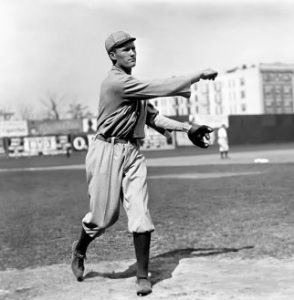
George Sisler made the Hall of Fame as a first baseman and a .340 career hitter, but he did a fair amount of pitching his rookie year
George Sisler: Sisler was primarily a first baseman and an outfielder as a rookie in 1915, but he also pitched 70 innings. He batted ninth in all of his pitching starts that season, even though he typically batted third (and never ninth) in other games. Sisler also batted ninth in the first game he started on the mound in 1916, despite having batted third or fourth in all his previous starts in the field that year. But in his two pitching starts later that season and one in 1918 he batted third. (That includes the game in which he pitched a 1-0 shutout against Walter Johnson and the Senators, which may make Sisler the only player in major league history to pitch a shutout while batting third.)
Allan Travers: Perhaps you’ve heard of the 1912 game when the Detroit Tigers players went on strike and the team hired a bunch of sandlot players to take their place for the day? Allan Travers, who pitched for Detroit that day, batted third. Travers went the distance on the hill that day and allowed 24 runs, still the most ever allowed by a pitcher in a major league game. It was his only professional baseball appearance; he went on to become a Jesuit priest.
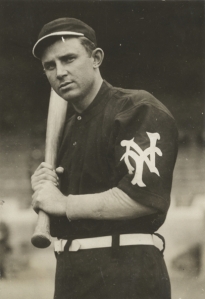
Otis “Doc” Crandall was a major league hitter as well as a major league pitcher
Doc Crandall: Crandall played a handful of games in the infield when he was with the Giants from 1908-13, even starting a few games at first, second and short, and was occasionally used as a pinch-hitter; he was a .285 career hitter. But he was primarily a pitcher, averaging 167 innings per season and establishing himself as one of the game’s earliest relief aces. When he jumped to St. Louis of the Federal League in 1914, he was used extensively at both second base (55 starts) and the mound (21 starts plus six relief appearances). He led the team in batting average with a .309 mark. Just to show how strong the instinct was to bat the pitcher ninth, he normally batted ninth that year when he pitched and higher in the order (as high as third) when he played second, but in his final three pitching starts that year he batted fifth (twice) or sixth. He was used exclusively as a pitcher the next year and won 21 games, while also pinch-hitting 35 times, and he batted seventh in one start. When he joined the St. Louis Browns in 1916 he was almost exclusively a pinch-hitter, and in his final major league season, with the Dodgers in 1918, he started three games on the mound and two in right field.
Ed Konetchy: Konetchy played more than 2,000 career games at first base. He batted in what was then his regular spot in the order, sixth, when he made his one major league pitching start in 1918 for the Boston Braves (pitching a complete game but getting clobbered). Konetchy also made two relief appearances in the majors and got credit for a victory with 4-2/3 innings of shutout relief in a game for the Cardinals in 1913. I have more about both those games in this post.
Jack Bentley: Bentley was both a batting and pitching star in the minor leagues (leading the International League in both RBI and ERA in 1920) and also pitched a little in the majors in his younger days. The New York Giants acquired him in 1923 as a pitcher, but in 1926, the Phillies picked him up and switched him to first base. He normally batted fifth when he played first, and Bentley also hit fifth in his first start as a pitcher that season, although he hit ninth in two later starts.
Bucky Walters: Walters was primarily a third baseman in the majors until he made his first pitching start in the final game of the 1934 season (he batted ninth in that game; in the first game of the doubleheader, starting at third base, he batted seventh, making him the last man in major league history to start one game of a doubleheader in the field and the other on the mound). From 1935 on he was primarily a pitcher, normally batting ninth except for a game when he batted seventh in 1935 and a game when he batted eighth (and pitched a shutout) in 1937. (Walters started games in the field in 1935 and 1937 and always batted higher in the order when he did.)
Johnny Lindell: Lindell reached the major leagues as a pitcher, having never played any other position in the minors, but was a full-time outfielder with the Yankees from 1943-50. He then went back to the minors, started pitching again, and returned to the majors as a pitcher in 1953. He typically batted ninth when he pitched that year, but he batted fifth in two of his starts (he also batted fifth in two starts at first base).
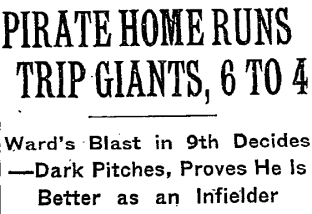 Al Dark: Dark was the leadoff hitter in the Giants’ final game of the 1953 season at Pittsburgh and pitched the first inning, then moved to third base. ADDED 8/12/21: From the New York Times account of this game: “Throughout his career, the captain of the Giants has wanted to pitch, and as the 1953 campaign came to a close, Dark was the starting hurler against the Pirates at Forbes Field. It was with reluctance that [Giants manager Leo] Durocher had granted Dark’s request to be permitted to hurl two innings. However, one frame of Dark’s mound work sufficed to convince Durocher that his captain was miscast.” In that one inning of work, Dark gave up a two-run homer to Frank Thomas. Dark singled in the second inning to raise his season batting average to an even .300, and after playing third base in the bottom of the second, he came out of the game to preserve his .300 season. His replacement at third was Wes Westrum — the only one of the 903 major league games he played in the field that Westrum played any position but catcher. One other note about this game: the Pirates’ second baseman was Dick Hall. In his first five major league seasons, Hall started at least one game at every position except shortstop and catcher. He became a full-time pitcher in 1957 and went on to a long career as a relief pitcher; his last major league appearance in Game 2 of the 1971 World Series, came two weeks after his 41st birthday.
Al Dark: Dark was the leadoff hitter in the Giants’ final game of the 1953 season at Pittsburgh and pitched the first inning, then moved to third base. ADDED 8/12/21: From the New York Times account of this game: “Throughout his career, the captain of the Giants has wanted to pitch, and as the 1953 campaign came to a close, Dark was the starting hurler against the Pirates at Forbes Field. It was with reluctance that [Giants manager Leo] Durocher had granted Dark’s request to be permitted to hurl two innings. However, one frame of Dark’s mound work sufficed to convince Durocher that his captain was miscast.” In that one inning of work, Dark gave up a two-run homer to Frank Thomas. Dark singled in the second inning to raise his season batting average to an even .300, and after playing third base in the bottom of the second, he came out of the game to preserve his .300 season. His replacement at third was Wes Westrum — the only one of the 903 major league games he played in the field that Westrum played any position but catcher. One other note about this game: the Pirates’ second baseman was Dick Hall. In his first five major league seasons, Hall started at least one game at every position except shortstop and catcher. He became a full-time pitcher in 1957 and went on to a long career as a relief pitcher; his last major league appearance in Game 2 of the 1971 World Series, came two weeks after his 41st birthday.
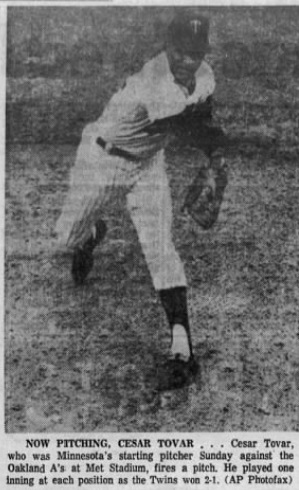 Cesar Tovar: Tovar was the starting pitcher and leadoff hitter in the game in which he played all nine positions in 1968.
Cesar Tovar: Tovar was the starting pitcher and leadoff hitter in the game in which he played all nine positions in 1968.
Shohei Ohtani: Ohtani’s miraculous 2021 season with the Angels saw him hit 46 home runs, drive in 100 runs, post a 9-2 pitching record with a 3.18 ERA, strike out 156 batters in 130-1/3 innings and win the American League’s Most Valuable Player award. In his 23 pitching starts he batted second 16 times and leadoff four times (in three starts, Angels manager Joe Maddon used a designated hitter). Ohtani started 10 games on the mound in 2018 and two in 2020, but the Angels used a designated hitter in each of those games. Ohtani is likely to be the only pitcher in the starting batting order anywhere in the majors with the implementation of the universal DH in 2022.
There’s one other pitcher I’m going to exclude: Andy Sonnanstine, because he batted third by accident, not by managerial design. That happened in a game in 2009; Sonnanstine was not listed in the original batting order, but he wound up hitting third after Rays manager Joe Maddon submitted a lineup card with two third basemen and no designated hitter. Sonnanstine took advantage of the rare opportunity to bat in an American League game by hitting an RBI double.
Okay, with those exclusions out of the way, here’s the rundown of times in which a team had the starting pitcher batting somewhere other than the ninth spot, by year, since 1901:
1901
Bill Phillips batted eighth for the Reds on May 6, and Frank Foreman batted eighth for the American League’s Baltimore Orioles on September 13. The 38-year-old Foreman went 4-for-4 in that game, pitched the first seven innings and was the winning pitcher in the Orioles’ 12-10 victory; he finished the season hitting .310.
1902
Starting on July 19, Cincinnati’s pitchers batted eighth in 18 of the next 19 games. Perhaps not coincidentally, Cincy’s catcher in all but one of those games and batting ninth was Bill Bergen, who was early in a career that would see him become arguably the worst-hitting regular position player in major league history (he finished his career with a 170/194/201 slash line in 947 games). Frank Bancroft was the Reds’ manager for the first nine of those games before Joe Kelley took over. The Reds batted their pitcher eighth one more time later that season, Noodles Hahn on August 29.
Brooklyn manager Ned Hanlon batted pitcher Frank Kitson eighth on May 16 (Kitson’s .274 batting average that season was the third highest on the team), then starting August 11 the Superbas’ pitcher hit somewhere other than ninth 16 times over the next 28 games, 12 of them in the eighth spot. Jay Hughes hit seventh on August 16, Doc Newton hit seventh on September 8. Meanwhile, Bill Donovan, who batted eighth three times, hit seventh on August 21 and fifth on August 24. Donovan led the National League with 25 wins in 1901 and went 17-15 on the mound in 1902, but beginning on August 19 he started eight games at first base, two in left field, two in right and one at second base over the rest of the season (typically batting fifth or sixth but sometimes cleanup) while continuing to pitch, even though as a .174 hitter on the season he wasn’t much of a threat with the bat. Donovan jumped to the American League’s Detroit Tigers after that season and continued to make occasional starts in the field while finishing his pitching career with 185 wins.
Wilbert Robinson took over as manager of Baltimore’s American League team after John McGraw left in early July, and over the rest of that season he moved his pitcher out of the ninth spot five times. Harry Howell hit eighth on July 19 and sixth in the first game of a doubleheader on August 2; he also batted sixth in the second game of that twin bill when he played second base. Howell started 23 times on the mound in 1902, but he also started 26 games at second, 15 at third, 10 at shortstop, eight in center field, four in left and three in right; he even got into a game at first base, and his 11 triples ranked second on the team. He never played as much in the field in any other season, but he did start games in the field in five other seasons. From 1904 through 1908 he posted a 2.01 ERA for the St. Louis Browns, and he won 131 games in his major league career. Also for the 1902 Orioles, Snake Wiltse batted seventh twice; one of those games was the second game of a doubleheader on July 25 after he had played first base and batted seventh in the first game. Wiltse pitched 302 innings that season, for the A’s and Orioles, but he also started 17 games in the field for the Orioles at five positions. Jack Katoll batted eighth in the first game of a doubleheader on September 27, then played left field in the second game (a game that saw Wiltse play second base and bat second and Howell play shortstop and bat third).
Clark Griffith, who managed and pitched for the 1902 White Sox, batted himself eighth twice, first on August 30 and then in the first game of a doubleheader on September 28. Griffith started the second game of that doubleheader in left field, his only start in the field that season.
Other pitchers who hit out of the ninth spot in 1902: Bill Carrick of Washington batted eighth on May 6 (Carrick started two games in the outfield that year), Jesse Tannehill of Pittsburgh batted eighth on June 9 (Tannehll started 13 games in the outfield that year and batted .291), Jimmy Callahan of the White Sox hit eighth on August 29 (Callahan started 21 games in the field in 1902 and moved exclusively to the field after that season) and Al Orth of Washington hit fifth on August 30 (he had hit fifth and started in right field in each of the Senators’ previous three games; Orth, who won 204 major league games as a pitcher, started eight games in the outfield in 1902 and saw action in the field in 13 straight seasons, 1897-1909).
1903
Only three true pitchers did not bat ninth in 1903: Henry Thielman of Brooklyn hit eighth on May 12 (after being primarily a pitcher in 1902, Thielman started three games on the mound and three in center field in 1903), Deacon Phillippe of Pittsburgh hit eighth on May 30 (Phillippe started one game in left field that year, three days before this, and hit seventh) and Tannehill, now with the American League’s New York Highlanders, hit seventh on July 11 (he got four starts in left field that year).
1904
Two teams batted the pitcher eighth extensively in 1904. Philadelphia A’s manager Connie Mack batted Rube Waddell eighth on May 14, then starting May 25 the A’s pitcher hit eighth 18 times over the next 20 games. On June 1 the Tigers, manged by Ed Barrow (later to gain fame as general manager of the Yankees, then a 36-year-old in his second season as a major league manager) batted the aforementioned Bill Donovan eighth, and the Detroit pitcher batted eighth for the next 37 games after that, which as we will see would be the longest streak of a pitcher not batting ninth until 1957. Then after the pitcher batted ninth in four games, Tiger pitchers batted somewhere other than ninth seven times in an eight-game stretch from July 20 through July 27, the last two of those games coming after Bobby Lowe had taken over as manager. George Mullin was the only pitcher who didn’t hit eighth, being in the seventh spot in the order on July 21. (Mullin won 228 games in the major leagues while hitting .262, and he saw frrequent duty as a pinch-hitter.) So Detroit pitchers batted above the ninth spot 45 times in 1904, 43 times under Barrow.
Cincinnati, still managed by Joe Kelley, hit the pitcher eighth in five straight games August 3-5 (with doubleheaders on the 3rd and 4th). The circumstances in those games were unusual; Bob Ewing and Win Kellum, normally pitchers, played center field in those games and batted ninth.
The only other pitcher who did not bat ninth in 1904 was Oscar Jones of Brooklyn, who batted eighth on July 23 and August 30.
1905
The only pitcher who did not bat ninth was Doc White of the White Sox on May 4. White had seen occasional outfield duty earlier in his career, and in 1909 he actually started more games in the outfield (36) than on the mound (21).
1906
The only pitchers who didn’t bat ninth were Barney Pelty of the Browns, who hit eighth on June 12, Nick Altrock of the White Sox, who hit eighth on June 25, and Mullin, who batted fifth for Detroit on July 31.
1907
Cardinals manager John McCloskey batted his pitcher eighth in seven straight games April 23 – May 1. The other St. Louis manager, Jimmy McAleer of the Browns, batted his pitcher eighth in both games of a doubleheader on June 17 (the pitcher in the second game was the aforementioned Harry Howell). Two other pitchers batted eighth, Long Tom Hughes of Washington on July 20 and Jack Chesbro of the Highlanders on September 16.
1908-1919
The A’s Connie Mack put his pitcher in the eighth spot eighth four times in September 1908, Jack Coombs three times and Eddie Plank once. Coombs debuted with the A’s in 1906, but when his arm went bad Mack moved him to the outfield to start the 1908 season, and he started 45 games there before going back to the mound. Plank also batted eighth in a 1910 game. Other pitchers who batted eighth in this period were Ben DeMott of Cleveland in 1911 and Jim Shaw of the Senators in 1914.
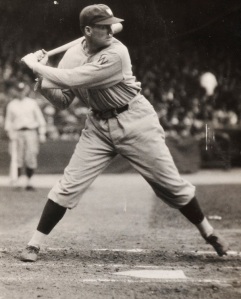
Walter Johnson batted as high as fifth in the order while pitching for the Washington Senators. This photo came from the Twitter account of the North Carolina band The Skimmers.
The first true pitcher who made extensive starts batting anywhere but ninth was Walter Johnson. In 1914 he batted sixth in his final start of the season (and homered!). In 1915 he batted sixth three times. Then in 1916 he batted seventh eight times, sixth once and batted fifth on June 1; no pitcher who did not also have extensive experience as a position player has hit that high in the order since. That made a total of 10 pitching starts in which Johnson did not bat ninth that year. In 1917 he batted eighth once; in 1918 he batted eighth once and seventh once; in 1919 he batted eighth once and sixth once. Clark Griffith was the Senators’ manager in all those seasons, giving him a known total of 20 games in which he batted the pitcher somewhere other than ninth (including Jim Shaw, mentioned above). From 1920 on Johnson hit only in the ninth spot as a starting pitcher. He actually started six games in the outfield in his career, never batting ninth in any of them (one in 1913 — the final game of the season in which he batted cleanup and also pitched and played second base — one in 1915, two in 1918 and two in 1919), and was a .235 career hitter.
John Picus “Jack” Quinn was nothing special at the plate in the American or National League, but in his two seasons with Baltimore in the Federal League (1914-15) he hit .268 and saw some pinch-hitting duty. In three of his pitching starts in September 1915 he batted sixth.
1920-1949
A starting pitcher batted above the ninth spot just eight times in this 30-year period, and only one season saw it happen more than once: 1933, when Cincinnati’s Red Lucas batted seventh on August 25 and September 7. Lucas was a .281 lifetime hitter who held the major league record for career pinch-hits for more than 30 years. He also started some games in the field; in 1925, he was the Boston Braves’ second baseman for the first six games of the season, and in 1927 with the Reds he started three games at second base, two games at shortstop and one game in left field, getting at least one hit in each game.
The other pitchers who didn’t bat ninth in this period were George “Hooks” Dauss of the Tigers in 1921, Eddie Rommel of the A’s in 1924, Waite Hoyt of the A’s in 1931 (a game in which Rommel started in left field and batted ninth, the first of three consecutive days Rommel started in the outfield), Herman Fink of the A’s in 1937, Jim Tobin of the Braves (managed by Casey Stengel, whose name we’ll see again later) in 1941 and Early Wynn of the Senators in 1947. All hit eighth except for Wynn, who became the first pitcher to be in the starting lineup batting sixth since Walter Johnson in 1919.
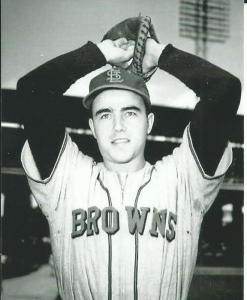
Ned Garver
1950
This was the first time a pitcher made more than two starts in a season batting outside the ninth spot since Johnson in 1919. The man who did it was Ned Garver, who hit .286 on the season and was used as a pinch-hitter six times for the St. Louis Browns. Garver batted eighth once, seventh once and sixth once. The next year, 1951, Garver was even better, winning 20 games for the last-place Browns (the rest of the team won 32) and batting .305, but he batted ninth in every game he started.
Also in 1950, Gene Bearden batted eighth in a game for the Senators. His manager was Bucky Harris, who will return in a moment.
1951
All starting pitchers batted ninth.
1952
For the first time since 1914 a manager used more than one pitcher in a season outside the ninth spot. That manager was Lou Boudreau, in his first year as skipper of the Boston Red Sox. Boudreau had not used the tactic in his nine years in charge of the Indians, but in 1952 he batted his pitcher eighth twice, seventh once and sixth six times, with six different pitchers involved. Allan Wood wrote extensively about Boudreau’s experiment at The Hardball Times, a story I hadn’t seen until I started researching this post…nicely done, Allan. All other starting pitchers in 1952 batted ninth.
1953
Boudreau also batted his pitcher higher in the order nine times in 1953, eight of them in the sixth spot; those events are also covered in Allan Wood’s post. Casey Stengel, now managing the New York Yankees, used Johnny Sain and Eddie Lopat in the eighth spot once each.
1954
Washington Senators manager Bucky Harris batted Mickey McDermott (a .252 career hitter) in the seventh spot 10 times, the most times any pitcher had hit above the ninth spot in a single season since Walter Johnson (him again) in 1916. McDermott was the only pitcher who didn’t bat ninth in ’54.
1955
Stengel batted his pitcher somewhere other than ninth 15 times. Tommy Byrne (a .238 career hitter) batted eighth eight times and seventh three times, and Don Larsen (a .242 career hitter) batted eighth four times and homered in the first of them (the only one of his 14 career homers he hit outside of the ninth spot in the order). Stengel was the only manager who batted a pitcher anywhere but ninth in 1955.
1956
First-year major league manager Bobby Bragan of the Pirates hit his pitcher seventh 21 times, all from July 26 through September 3, with seven different pitchers involved. That’s still by far the most games a team has had a pitcher bat seventh (the 1954 Senators with McDermott being next on the list). Stengel batted Larsen and McDermott (now a Yankee) in the eighth spot once apiece. Dick Donovan of the White Sox batted eighth once and never actually got to the plate; he was knocked out of the box in the first inning.
1957
After his 1952-53 experiment in which he moved the pitcher up in the order a total of 18 times, Lou Boudreau had batted his pitcher ninth in every game with the Red Sox in 1954 and again in every game during his first two seasons in the A’s dugout in ’55 and ’56. But in 1957 Boudreau batted his pitcher eighth for the first 56 games of the season, ending on June 15. That broke Ed Barrow’s 1904 record for most times not batting a pitcher ninth in a season, and with a career total of 74 Boudreau also established the record — for now — in that category. (Boudreau would be fired in early August.)
Bragan batted his pitcher eighth in the first two games of the season and then abandoned the tactic; like Boudreau, he would be fired before the end of the season. Two other managers used a pitcher outside the ninth spot in 1957: Stengel batted Don Larsen eighth twice and seventh three times (bringing Casey’s career total to 25), and Bob Lemon hit seventh once and eighth twice for Cleveland manager Kerby Farrell. Lemon reached the major leagues as a third baseman and opened the 1946 season as the Indians’ center fielder, but he had only 66 major league plate appearances before becoming a full-time pitcher. Although Lemon batted second as a center fielder, he hit ninth as a pitcher in 1946 and in every other game he started except these three.
But after all the records set in 1957, the practice of batting the pitcher anywhere but ninth came to an almost complete halt for 40 years. It didn’t help that the most prominent advocates of the tactic, Boudreau and Bragan, had both been fired; of course, Stengel was the era’s most successful manager, but he used the tactic with some of the best-hitting pitchers of the day (Larsen, Byrne, McDermott).
1958-1997
In this 40-year span a starting pitcher batted anywhere but ninth just five times.
In 1965 Don Drysdale — who hit .300 that year with seven home runs in 130 at-bats and was used as a pinch-hitter 14 times for a woefully weak-hitting Dodger team — batted seventh in a game on August 15.
In 1968 Gary Peters, arguably one of the best hitters on an awful-hitting White Sox squad (he was used as a pinch-hitter 17 times), batted sixth on May 26. No pitcher has appeared that high in the lineup since.
In 1973 Steve Renko, who started his minor league career as a first baseman, batted seventh on August 26 and stroked a single and a double to raise his batting average for the season to that point to .292. This was also the first season of the designated hitter in the American League, meaning the number of teams that could even try to bat the pitcher anywhere but ninth was diminished.
But the next pitcher to move up in the order was an American Leaguer. In 1976 Ken Brett, who finished his career with a .406 slugging percentage, batted eighth in a game on September 23. Brett was the only pitcher ever to start the game batting anywhere other than the ninth spot (on purpose) in a game in which the designated hitter was available until Shohei Ohtani in 2021. (Four pitchers have hit for themselves and batted ninth in a game with the DH: Ferguson Jenkins on the last day of the season in 1974 (he singled and scored the game’s first run on the way to his 25th win of the year), Ken Holtzman on the next-to-last day of the season in 1975, Brett in 1976 and Madison Bumgarner of the National League’s Giants in a 2016 game at Oakland in which the DH was allowed.)
Then in 1979 Steve Carlton batted eighth on June 1.
1998
More than 19 years after any starting pitcher had batted anywhere than ninth, Tony La Russa of the St. Louis Cardinals shook things up. Starting July 9, La Russa batted his pitcher in the eighth spot in each of the last 77 games of the season, breaking Lou Boudreau’s season and career records. Kent Mercker even hit a grand slam home run as the number eight hitter on September 2, the only homer of his major league career.
1999-2003
La Russa’s tactic didn’t catch on, even with La Russa (yet). All starting pitchers batted ninth during this five-year period.
2004
Tomo Ohka, who went just 2-for-25 on the season and hit just .138 in his major league career, batted eighth for Montreal manager Frank Robinson on May 30. The Expos had lost eight of their previous nine games, and Robinson said he wanted “to try something different.”
2005
Dontrelle Willis, one of the better-hitting pitchers of the modern era (a .244 career average with nine homers in 389 at-bats), was moved up in the lineup four times by manager Jack McKeon, batting eighth twice and seventh twice. When he batted seventh in the final game of the season on October 2, it marked the last time as of this writing that a starting pitcher batted above the eighth spot.
2006
This is the last year that all starting pitchers batted ninth.
2007
Tony La Russa rediscovered this tactic on August 4, batting his pitcher eighth in each of the last 56 games of the season.
2008
La Russa goes all the way, batting his pitcher eighth in all 153 games in which the Cardinals could not use a designated hitter. And for the first time since 1957, multiple managers used the tactic. Milwaukee’s Ned Yost batted his pitcher eighth 42 times in the Brewers’ first 49 games. Pittsburgh’s John Russell batted his pitcher eighth 26 times in a 27-game stretch from June 30 through July 30. And Arizona manager Bob Melvin batted Micah Owings (who had a career major league average of .283 with a .502 slugging percentage) eighth on June 4. The total of 222 times that a starting pitcher did not bat ninth in 2008 was the most of any season to that point. And 2008 saw the first games in major league history in which neither team batted the pitcher ninth; details are coming up.
2009
La Russa batted his pitcher eighth 55 times through July 21, then abandoned the tactic for the rest of the season, including the three-game playoff series against the Dodgers. A record total of five teams had their pitcher bat outside the ninth spot at least once. Milwaukee manager Ken Macha did it nine times in August; the Dodgers’ Joe Torre did it eight times; San Diego’s Bud Black did it three straight games in June; and Kansas City’s Zack Greinke became the first American League pitcher to bat eighth since 1976 on June 23.
2010
La Russa batted his pitcher eighth in 77 games, while in Pittsburgh John Russell, who did not bat his pitcher eighth in 2009, did so in the Pirates’ first 24 games. Milwaukee’s Macha did it three times and San Francisco’s Bruce Bochy hit Tim Lincecum in the eighth spot on May 20.
2011
The pitcher-hits-eighth tactic died down, as LaRussa did so only 14 times, never after July 19, including the postseason in which the Cards won the World Series. Washington’s Jim Riggelman batted the pitcher eighth in 11 straight games in June, and Atlanta’s Fredi Gonzalez did it three times in August.
2012
With La Russa retired and his successor Mike Matheny always batting his pitcher ninth, pitchers batted eighth fewer times than in any season since the tactic was revived in 2007. Atlanta’s Gonzalez had the pitcher bat eighth five times in an eight-game stretch in late May and early June, making him the only manager to do so more than once. Madison Bumgarner batted eighth for the Giants’ Bochy on May 16, and Cubs skipper Dale Sveum had Jeff Samardzija bat eighth on September 8.
2013
Only two starting pitchers batted anywhere other than ninth. David Phelps batted eighth for the Yankees and manager Joe Girardi in a game at Colorado on May 8, and Jeremy Hellickson batted eighth for the Rays and manager Joe Maddon in a game at Dodger Stadium on August 11. It was the first time using the tactic for both managers (well, for Madden, the first time he had the pitcher bat somewhere other than ninth on purpose).
2014
A slight revival in the tactic, as four managers put their pitcher in the eighth spot a total of 27 times. Atlanta’s Fredi Gonzalez did it 10 times in an 11-game stretch in May and the Mets’ Terry Collins likewise did so 10 times (five times with rookie Jacob deGrom, who collected a pair of hits in the eighth spot and batted .217 on the season). Tampa Bay skipper Joe Maddon did it six times (and got RBI from Jake Odorizzi and Alex Cobb) and San Diego’s Bud Black did it May 18 at Denver with Donn Roach.
[ADDED 4/10/15]: Today’s Cubs-Rockies game features pitcher Travis Wood (with nine home runs in 239 career at-bats at the start of the game) batting eighth for the Cubs and Tyler Matzek bating eighth for the Rockies (adding Colorado manager Walt Weiss to the list of skippers who have used this tactic). Matzek doubled in what turned out to be his only at-bat and scored the game’s first run. ESPN SweetSpot blogger Richard Bergstrom alerted me to this and wrote about it here. Richard asked if this was the first time ever both teams had the pitcher higher than ninth in the order. Turns out it had happened 11 times in 2008, all in games involving Tony La Russa (click on the dates to see the box score).
| Date | Visitor (Pitcher) | Home (Pitcher) |
| 4/15/2008 | Milwaukee (Dave Bush) | St. Louis (Braden Looper) |
| 4/16/2008 | Milwaukee (Carlos Villanueva) | St. Louis (Adam Wainwright) |
| 4/21/2008 | St. Louis (Adam Wainwright) | Milwaukee (Carlos Villanueva) |
| 4/22/2008 | St. Louis (Kyle Lohse) | Milwaukee (Manny Parra) |
| 5/9/2008 | St. Louis (Todd Wellemeyer) | Milwaukee (Manny Parra) |
| 5/10/2008 | St. Louis (Joel Pineiro) | Milwaukee (Ben Sheets) |
| 5/11/2008 | St. Louis (Braden Looper) | Milwaukee (Jeff Suppan) |
| 5/12/2008 | St. Louis (Adam Wainwright) | Milwaukee (Dave Bush) |
| 7/11/2008 | St. Louis (Kyle Lohse) | Pittsburgh (Zach Duke) |
| 7/12/2008 | St. Louis (Todd Wellemeyer) | Pittsburgh (Yoslan Herrera) |
| 7/13/2008 | St. Louis (Joel Pineiro) | Pittsburgh (Ian Snell) |
Ned Yost managed the Brewers in those games, John Russell the Pirates.
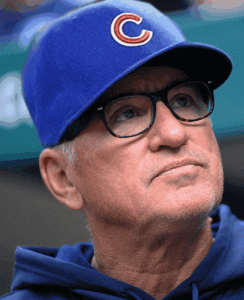
Joe Maddon is the only manager to threaten Tony LaRussa’s season record for batting the pitcher higher than ninth
2015
Starting pitchers batted eighth 283 times in 2015, the most for any season to date, as a record 13 managers used the tactic. Cubs manager Joe Maddon led the way by hitting his pitcher eighth in 140 of the Cubs’ 152 games that didn’t allow a designated hitter, moving into second place behind Tony La Russa on the career list, and only La Russa in 2008 did this more often in a season.
Unlike La Russa, Maddon also batted his pitcher eighth in the postseason, although not in every game. Kyle Hendricks and Jason Hammel each hit eighth in their playoff starts, once each in the National League Division Series and the National League Championship Series, making them the only pitchers aside from Babe Ruth to bat higher than ninth in the postseason, at least since 1903.
Cincinnati’s Bryan Price, a former pitcher, put his hurler in the ninth spot in all non-DH games in his first year as a manager in 2014, but in 2015 he hit the pitcher eighth 58 times and moved into fourth place on the career list.
Other managers who had the pitcher bat eighth more than once in 2015 were the Mets’ Terry Collins (25), San Diego interim manager Pat Murphy (23), Milwaukee’s Craig Counsell (12), Colorado’s Walt Weiss (8), Arizona’s Chip Hale (6), Minnesota’s Paul Molitor (5) and the Dodgers’ Don Mattingly (2). Kansas City’s Ned Yost (with Jeremy Guthrie), the Angels’ Mike Scoscia (with Jered Weaver), Miami’s Dan Jennings (with David Phelps) and San Francisco’s Bruce Bochy (with Madison Bumgarner) all did so one each. For Scoscia, it was the first time he hit his pitcher anywhere other than ninth in his first 16 seasons as a major league manager, although it should be noted the Angels have played only 147 games without the DH in that time.
The April 10 Cubs-Rockies game was the first of 14 in 2015 in which both pitchers batted eighth. There were 13 such games through July 20, all of them involving the Cubs or the Mets (three of them involving both), then the only game after that involved neither of them. Here’s the full list (which I fixed on 4/4/16, thank you Diane Firstman):
| Date | Visitor (Pitcher) | Home (Pitcher) |
| 4/10/2015 | Cubs (Travis Wood) | Colorado (Tyler Matzek) |
| 4/12/2015 | Cubs (Kyle Hendricks) | Colorado (Jordan Lyles) |
| 5/12/2015 | Mets (Noah Syndergaard) | Cubs (Jake Arrieta) |
| 5/16/2015 | Milwaukee (Matt Garza) | Mets (Jacob de Grom) |
| 5/17/2015 | Milwaukee (Wily Peralta) | Mets (Noah Syndergaard) |
| 6/11/2015 | Cincinnati (Michael Lorenzen) | Cubs (Tsuyoshi Wada) |
| 6/12/2015 | Cincinnati (Johnny Cueto) | Cubs (Jason Hammel) |
| 6/13/2015 | Cincinnati (Mike Leake) | Cubs (Kyle Hendricks) |
| 6/14/2015 | Cincinnati (Anthony DeSclafani) | Cubs (Jon Lester) |
| 6/26/2015 | Cincinnati (Johnny Cueto) | Mets (Noah Syndergaard) |
| 6/30/2015 | Cubs (Kyle Hendricks) | Mets (Jon Niese) |
| 7/2/2015 | Cubs (Jake Arrieta) | Mets (Jacob de Grom) |
| 7/20/2015 | Cubs (Clayton Richard) | Cincinnati (Michael Lorenzen) |
| 9/1/2015 | San Francisco (Madison Bumgarner) | Dodgers (Zack Grienke) |
Rookie Michael Lorenzen of the Reds, a slugging outfielder as a collegian at Cal State Fullerton who was used four times as a pinch-hitter in 2015, hit .368 (7-for-19) in 11 games he started batting in the eighth spot, with a triple and four RBI. His teammate Anthony DeSclafani was 5-for-11 with a double in his first six starts batting eighth, 0-for-10 in last last five.
ADDED 4/5/22: Lorenzen had an unusual achievement for the Reds in a 2019 game. He pitched two innings in relief and got the win (vultured it, actually as he gave up a game-tying homer before the Reds rallied), hit a two-run homer, then moved to center field for the ninth inning.
Jake Arrieta of the Cubs was 0-for-27 in his first 12 starts batting eighth, and 0-for-9 in his last three, but in the 12 starts in between he went 9-for-33 (.273) with a double, a triple and a home run (he also hit a home run in one of his four starts batting ninth, and those homers accounted for his only two RBI in 83 plate appearances).
ADDED 4/4/16: Thanks to Diane Firstman at her Value Over Replacement Grit blog, who notes today’s game between the Giants and Brewers marks the first Opening Day game in which both pitchers batted eighth (Madison Bumgarner and Wily Coyote Peralta). Check out her post here.
2016
A record 14 managers batted the pitcher eighth in 2016, a total of 171 times…but there were signs use of the tactic was actually cooling off, as the pitcher hit eighth just 12 times after the All-Star break (65 times in April, 62 times in May). Joe Maddon hit his pitcher eighth 140 times in 2015 but did so only nine times in 2016, and Cincinnati’s Bryan Price reduced his use of the tactic from 58 times in 2015 to 13 in 2016, all of them in April.
On the other hand, two veteran managers increased their usage in 2016. San Francisco’s Bruce Bochy, who hit his pitcher eighth just three times in his first 21 seasons in the dugout, did so 27 times in 2016. (Eleven times that pitcher was Madison Bumgarner, who hit a homer off Clayton Kershaw while batting eighth on April 9. Bochy also allowed Bumgarner to hit for himself in a game at Oakland on June 30 in which the designated hitter was allowed…the first time a manager had eschewed the DH — except for the Andy Sonnanstine snafu — since 1976.) And the Angels’ Mike Scioscia, who hit his pitcher eighth only once in his first 16 seasons as a manager, did so in all 10 of his non-DH games in 2016. Bochy and Scoscia were among the few managers (only five) who used the tactic after August 1.
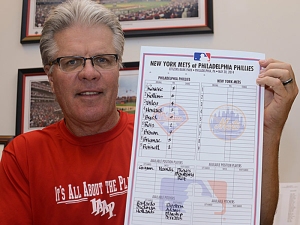
The pitcher is hitting ninth in this lineup card displayed by Pete Mackanin, but Mackanin hit his pitcher eighth 35 times in his first full season as a big league skipper in 2016
Four managers joined the pitcher-batting-eighth club in 2016, and one of them used the tactic more than anyone else during the season: Pete Mackanin of the Phillies, who did so 35 times, all in a 56-game stretch from April 20 through June 20. Other newbies were Brian Snitker, who did it 15 times after taking over as Atlanta’s manager on May 17 (his predecessor, Fredi Gonzalez, did it seven times); San Diego’s Andy Green, who did it five times; and Texas’ Jeff Bannister, who did it once.
Other skippers who hit their pitcher eighth in 2016: Arizona’s Chip Hale (30, including Zack Greinke 14 times, the most any pitcher batted eighth in 2016; Greinke was 8-for-31 in those games for a .258 average, just 3-for-21 in his other games); Milwaukee’s Craig Counsell (12); Colorado’s Walt Weiss (4); Minnesota’s Paul Molitor (2); and the Mets’ Terry Collins (1).
There were 11 games in which both starting pitchers batted eighth in 2016, but the last of them came on May 22.
2017
2016 was just a temporary decline in batting the pitcher eighth for the Cubs’ Joe Maddon, as he put the pitcher in the eighth spot 54 times in 2017. But the last of those came on June 28, and he hit his pitcher ninth in all the Cubs’ postseason games. Five other managers used the tactic, all of whom had done so before: Miami’s Don Mattingly (five times), San Diego’s Andy Green (three), the Mets’ Terry Collins (two), Colorado’s Bud Black (one) and the Angels’ Mike Scioscia (one). The pitcher hit eighth only three times after the All-Star break. There were no games in which both pitchers hit eighth.
2018
Batting the pitcher eighth may have faded out late in the 2017 season, but it came back strong in 2018, as it was done a total of 282 times by 11 different managers, including nine of the 15 teams in the National League. (Aaron Boone was the only American League manager to do so, in four games at N.L. parks.) Only 2015 saw the pitcher bat eighth more often, and just barely. Fourteen games saw both pitchers bat eighth. tying the record set in 2015.
A lot of the jump in use of this tactic came from first-time managers, especially the Mets’ Mickey Callaway (49 times), Philadelphia’s Gabe Kapler (36) and Washington’s Dave Martinez (29). Joe Maddon did it 53 times, similar to his 2017 total. But the unlikely leader in this category was a 65-year-old man who first managed in the majors in 1992.

Jim Riggelman batted his pitcher eighth 11 times in 1,486 games before 2018, 90 times in 144 games in 2018.
Jim Riggelman had hit his pitcher eighth 11 times when he managed Washington in 2011, but after he took over the Reds in April 2018 he went wild, batting the pitcher eighth 90 times! Only Maddon and Tony La Russa have done it more in a season…heck, only Maddon and La Russa have done it more in a career. Riggelman took over the managerial reins from Bryan Price, a former pitcher who is also among the all-time leaders in batting the pitcher eighth (and did so in seven of the 18 games he managed in 2018).
Other skippers who hit the pitcher eighth in 2018 were Atlanta’s Brian Snitker (7 times), Miami’s Don Mattingly (3), San Diego’s Andy Green (2) and San Francisco’s Bruce Bochy (2), all of whom had used the tactic before. (By the way, neither Snitker nor Maddon hit the pitcher eighth in the postseason; they were the only managers who used the tactic during the regular season who advanced to the playoffs.)
Cincinnati’s Luis Castillo and Matt Harvey hit eighth the most often, 19 times each (two of Harvey’s came when he was with the Mets). Anthony DeSclafani of the Reds had six hits while batting eighth, the most of any pitcher, including a grand slam home run June 23. He was one of three pitchers who homered batting eighth, along with Cole Hamels of the Cubs and Steven Matz of the Mets; that’s the most homers in a seaon for pitchers batting eighth.
Looking at all the starting pitchers who batted eighth, they hit .133 in those games (69-for-518), a little better than pitchers hit in all other at-bats (.113).
2019
Eight different managers batted the pitcher eighth 130 times, led by Cincinnati’s rookie manager David Bell, who did so 34 times. He was followed by Washington’s Martinez (28), the Cubs’ Maddon (22), San Diego’s Green (15), Milwaukee’s Counsell (15), Philadelphia’s Kapler (10) and Colorado’s Black (4). Bruce Bochy of the Giants hit his pitcher eighth twice, both times the pitcher being Madison Bumgarner.
2020
With the universal DH adopted in this COVID-shortened season, no pitcher appeared in the batting order in any spot in 2020.
2021
The pitcher batted eighth only 33 times in 2021, plus there were 20 games in which Shohei Ohtani batted either first or second. Only five managers used the tactic; one of them was Joe Maddon, now with the Angels, whose pitcher hit ninth only once in their 12 interleague games. Ohtani started three of those games and hit second in all of them, and in eight games the pitcher hit eighth. All told, Maddon batted his pitcher somewhere other than eighth 28 times. The other skippers who batted the pitcher eighth were Washington’s Martinez (16), Luis Rojas of the Mets (5), Cincinnati’s Bell (3) and Dusty Baker of the Astros, who batted Zack Greinke eighth in an interleague game on July 31.
Here is the list of the managers who have batted their pitcher outside the ninth spot the most from 1901 through 2021. (Joe Maddon’s total includes Ohtani.)
| Tony La Russa | 432 |
| Joe Maddon | 313 |
| Jim Riggelman | 101 |
| Bryan Price | 78 |
| Lou Boudreau | 74 |
| Dave Martinez | 73 |
| John Russell | 50 |
| Mickey Callaway | 49 |
And here’s the list of single-season leaders in batting the pitcher higher than ninth:
| Tony La Russa | 153 | 2008 Cardinals |
| Joe Maddon | 140 | 2015 Cubs |
| Jim Riggelman | 90 | 2018 Reds |
| Tony La Russa | 77 | 1998 Cardinals |
| Tony La Russa | 77 | 2010 Cardinals |
| Bryan Price | 58 | 2015 Reds |
| Lou Boudreau | 56 | 1957 A’s |
| Tony La Russa | 55 | 2009 Cardinals |
| Joe Maddon | 54 | 2017 Cubs |
| Joe Maddon | 53 | 2018 Cubs |
| Mickey Callaway | 49 | 2018 Mets |
| Ed Barrow | 43 | 1904 Tigers |
I’ve worked to make this completely accurate, but if you find any errors or omissions here, please let me know. I’ll be happy to give you credit when I fix it.
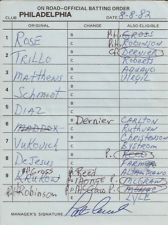
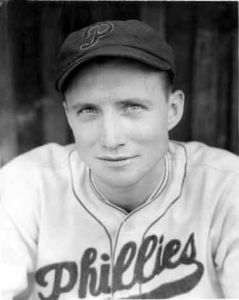
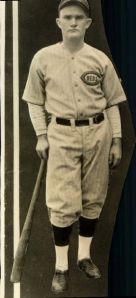
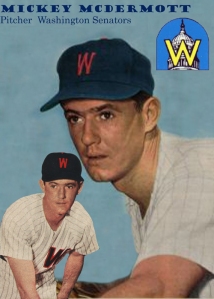
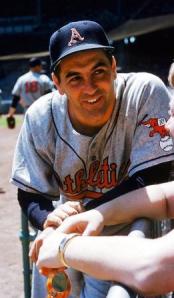

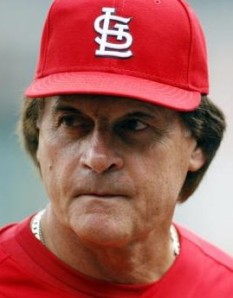

This is a wonderful post (and, for that matter, wonderful subtitle).
Pingback: The unusual pitching career of Ed Konetchy | The J.G. Preston Experience
How about a story researching the lefty-righty theory. I’m been noticing a lot of lefty’s with higher averages against lefty pitchers and the same for the right-righty combination.
Fabulous article.
Pingback: Why Not Bat the Pitcher Eighth? (Because No One Else Does) | Brewers Bar
With LaRussa it was not so much he was batting the pitcher 8th as much as he was batting Ozzie Smith 9th. It was an insult to Smith not a compliment to the pitchers.
By the way I am searching for the last time a team was down to their final out and let the pitcher bat. Can you help me? Thanks!
Can’t help you with your question…but I can tell you Ozzie Smith retired in 1996, two years before LaRussa ever batted a pitcher ninth.
Wow you are right. Seems to me I was reading back then about LaRussa batting Smith 9th because he was not pleased with him, but you are right that’s impossible. I must have dreamed it.
Man, I am old, and it’s amazing that people will rely on their memory for anything. We live in an age where the amount of information available is incredible. Before I post anything, I verify it most of the time. If I don’t verify it, I make that clear.
Mr. Preston, I love reading your articles.
That’s kind, thank you! And I definitely need to bring this piece up to date…I’ll work on that over the holidays.
I’d like to see the pitcher hit leadoff because the leadoff ab of every game is the only guaranteed ab in the game to not have an opportunity for a RBI. Get that first out done with so that in the 2nd inning, if there’s a few guys on base and the 9th hitter is up, it’d be a regular hitter and a better chance to knock guys in to score.
If the lead off batter hits a home run that’s an RBI. 🙂
this makes no sense. leadoff hr is a leadoff rbi. and also, if you want a pitcher to bat first so the 9th guy can get an rbi, what you are saying is its ok to start a game with 1 out and give the beginning of the lineup less base runners because #9 isnt a pitcher? im guessing you’re not a manager.
I’ve been curious about this as well. It often seems that by the time the pitcher comes to bat, there are men on base with two outs and the side is retired (and it’s usually too early in the game to substitute a pinch hitter). Yes, batting the pitcher first would probably be an immediate out, but the first batter up is usually an out anyway. At least this way, you wouldn’t leave anyone stranded on base.
Want to stay updated? The Mets vs. Brewers today have both pitchers batting 8th. Mets also did this yesterday.
Thanks. I won’t do a full update until the end of the season.
Very nice blog post. I look forward to reading more.
Thank you for your kind words.
Technically, this doesn’t count, but pitcher Rick Rhoden batted seventh in 1988—as the Yankees’ starting DH. See http://www.nytimes.com/1988/06/12/sports/baseball-rhoden-pitches-in-a-designated-hitter.html .
0 – 1 with an rbi sac fly
The only reason for batting the pitcher in any position other than 9th would be improving the team’s offense. Except for a few players–Wes Ferrell, Red Lucas, Bob Lemon, Dontrelle Willis–pitchers strike out too much (far more than position players, even at today’s rate), the offense is not going to improve. I remember LaRussa attempting to explain batting the pitcher 8th, and it never made sense.
Concerning why good hitting pitchers like “Hall of Famers Babe Ruth and George Sisler both batted ninth as pitchers in seasons during which they hit in the heart of the order when they played in the field.”
For “away games”, the visiting team’s pitcher would be warming up while his teammates batted in the top of the first inning. If the visiting pitcher bats ninth, his pre-game warm-up pitching routine will almost certainly not be interrupted. But for the home team, have a good-hitting pitcher bat towards the top of the line-up makes a lot more sense.
The single biggest reason why Cincinnati Reds managers used the tactic in 2015 through 2018 was on account that they wanted to take advantage of Billy Hamilton’s blazing speed on the base paths for stealing, including when Billy leaped a hurling high jump over the first baseman on the baseline from home plate to first base to reach safely, and with that same blazing speed would get a lot more outs as their center fielder including climbing up the outfield wall with just his feet, but Billy’s batting average was so low with getting on base to the point it was closer to that of a typical pitcher batting average than the Mendoza Line (.200 batting average). As such, they often had the pitcher batting 8th with Billy Hamilton batting 9th.
I could just see a game where you have Aroldis Chapman as the pitcher on the mound pitching up to 105MPH with Billy Hamilton on first base with his 23MPH speed. Not quite as fast as a 100M sprinter of about 25MPH, but still faster than a long distance (5+ miles) runner of about 14MPH. Just imagine that competition between the 2 players in that situation.
Lorenzen was the only pitcher to receive an AB in 2020 despite it not being as a starting pitcher (possibly started in RF, IDR) And the 21 All-star game was the only ASG to feature a pitcher hit other than 9th despite the rules being changed so Ohtani could do so technically as a DH
Does anyone have any info on this pre-1901 or in the Negro Leagues? The Fed league was mentioned but pitchers were used differently in the 19th century, especially in the early National Association days and it would be interesting to see how the batting 9th theory progressed as the type of play evolved. I remember reading two things about the 2022 season related to Ohtanis 2 way use, one he was the first player at any point after mid season to lead a team in ABs and Wins since Jim Devlin in the 1880s and was the first player to start both ends of a double header as pitcher and DH technically the first to do so as a pitcher and position player since Jimmie Foxx’ final season at age 37 during World War 2. He made 2 starts & pitched 20+ innings essentially as a replacement player for a woefully Phillies team that had a few position players forced to eat innings which ironically would have never happened had Bill Veecks plan to buy the team and roster it entirely with Negro League All-stars gone through in 1943.